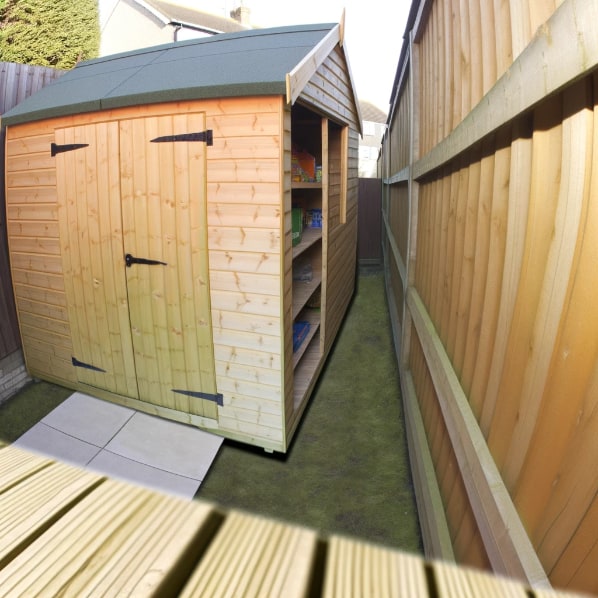Jump to:
When you install a new shed at your property, it may be tempting to place it right at the edge, up against your fence, to maximise your leftover outdoor space. However, doing this could not only be legally risky, but also cause damage to your building.
What’s the Minimum Distance Between Shed and Fence?
Generally, your wooden shed should be at least 1 metre (3 ft.) from the fencing and should not exceed 2.5 metres in height. Plus, with 0.6 metres (2 ft.) to spare, you should also have enough room to access the building when making changes. This requirement vary depending on the area you live in.
An application for planning permission may be needed if it’s closer or higher, according to experts. This often applies when the outdoor shed falls within the one-metre rule. Meaning, any part exceeding 14 metres in height or with eaves exceeding 3 metres.
The same condition follows suit if the total area of the outbuilding exceeds 50% of the garden’s area. Minimum distance and planning permission requirements also apply for metal sheds and plastic sheds. While they’re generally safer than wooden sheds in terms of fire risks and durability, proper ventilation and airflow are still important to prevent rust or damp issues.
Remember, these are just guidelines. You can check the official permitted development fences guideline for more information. Alternatively, contact your Local Planning Authority (LPA) for help.
Why Can a “Too Close” Minimum Distance Between Shed and Fence Lead to Issues?

Now, consider if it’s your neighbour’s fence rather than your own. You might be tempted to put your shed nearby, especially if you get along well with them. Although not required, it’s advisable to discuss the matter with them.
Consulting them about how the placement may impact their garden shows courtesy. Failure to do so could lead to penalties or legal issues, such as fines or being required to move the shed. Maintaining positive relationships with neighbours also avoids disputes. Learn more about laws on fencing between neighbours.
Too close to the fence will prevent the wooden storage from breathing. This can result in shed condensation, mould build-up, and limited access. For instance, it would make it harder for you to get around the back and side of the shed to apply its annual wood treatment.
Adhere to local regulations and place your shed appropriately. Doing so will not only save time and money but also keep your neighbours happy.
What Are the Rules and Regulations Apply in the UK?
Homeowners can build a shed without permission from their local council. However, there are some specific rules, including how close a shed can be to a fence. In some cases, LPAs will have specific regulations on the minimum distance. Do your research and adhere to these rules before construction if this applies to your area.
If there aren’t any specific rules for your area, you can use the guidelines outlined above. Keeping at least 1 metre of space will give you room for maintenance and future expansion. With this in mind, you should have no trouble placing a shed exactly where you want it!
Round-up
It’s important to know the rules on minimum distance between shed and fence requirements. Following these helps you avoid problems with the law and neighbour disputes. Just make sure to check the regulations in your area and talk to your neighbours if needed. This way, you can enjoy your shed and fence without any worries.
We offer a range of garden sheds for sale with heights not more than 2.5 metres. You can position one to a fence without the concern of planning permission. If you have any further questions, contact us and don’t hesitate to call us at 01909 768840.
For more positioning tips, read this next: Things to Consider When Positioning Your Shed










